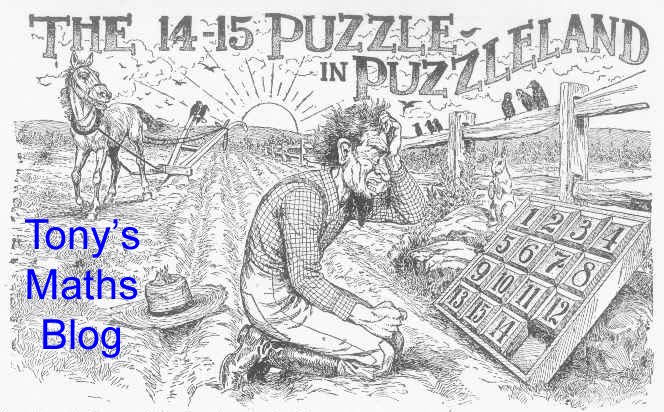The Times Higher has reported a conference talk by the writer Simon Singh about public engagement in science under the heading "Simon Singh criticises wasteful science outreach". This has even led to the ultimate distinction of a mention in Laurie Taylor's Poppletonian, the comic column which is consistently the highlight of my week.
Now, not only did I not hear Singh's talk, so that I am relying on the THE report, but Singh is one of my heroes for his contributions to mathematics and its public reputation. For one thing, his documentary film on Andrew Wiles's proof of Fermat's last theorem conveyed to the general public the emotion and the joy of doing mathematics, and what the profession is about, in a way which was almost unprecedented. His subsequent writings - the book on Fermat's Last Theorem, the book on codes (and the wonderful CD-rom he made with Nicholas Mee), his recent book on the maths of The Simpsons and others - have continued to inform the public and inspire young mathematicians. And his creation of the undergraduate ambassador scheme, which puts maths undergraduates into schools and colleges, is a hugely important contribution to maths education in the UK, directly benefiting school and university students and motivating many outstanding graduates to become maths teachers. So his views on public engagement certainly deserve to be taken seriously.
But on this I disagree with Singh's comments (at least as they are reported). He says that in his view the best science outreach is "largely dirt cheap". Well, there is certainly a lot of excellent public engagement work on mathematics that is done on the cheap (such as the Royal Institution Masterclasses and the British Science Festival, the power of both of which I have seen at first hand), and a large number of people doing it more or less in their spare time for no reward other than the joy of communicating mathematics. But it shouldn't be like that, and it isn't only like that,
Singh is critical of the funding of a ballet about relativity. "People hate physics, they hate ballet, all you've done is allowed people to hate things more efficiently." Well, I believe that science and mathematics are so important that they should feature prominently in art. There should be ballets, novels, operas about mathematics. Happily, thanks to people like Marcus du Sautoy, Scarlett Thomas, Dorothy Ker and a great many others, there are. Not everyone hates ballet: a dance piece about science is potentially reaching a valuable audience. When Singh says of the "Faces of Mathematics" project of portraits of mathematicians that "I don't quite understand how this is really going to have an impact", he is surely not using his imagination. We need to show the world the diverse nature of mathematicians to encourage the aspirations of the potential mathematicians of the future,
Of course Singh is right to suggest that the value for money of any outreach project should be compared with the cost of a teacher. And we certainly need more teachers, and to pay them better. But imaginative (and expensive) public engagement projects are also important. They won't all succeed, Singh's TV programme about Wiles was of inestimable value in showing what mathematics is about. Dance and photography projects promoting public engagement with mathematics and science have similar potential. Even when they fail, they are not wasteful.
Sunday 25 October 2015
Thursday 8 October 2015
The Mpemba Paradox
As a mathematician I love mathematical paradoxes because they are disturbing and thought-provoking. For example, Parrondo's Paradox tells us something counter-intuitive about probabilistic games; Simpson's paradox reminds us that we have to think carefully about statistics; and Curry's paradox is just mind-bending.
Paradoxes in the sciences are important because they make us think about our theories and where they don't quite match reality, driving new scientific ideas. My favourites include Olbers' Paradox (why is the sky dark at night?) and the EPR Paradox which shows us just how surprising the world is.
So I was delighted to come across, in an article by Oliver Southwick in the excellent magazine Chalkdust, a paradox that was new to me, the Mpemba Paradox. "If you take two similar containers with equal volumes of water, one at 35 °C (95 °F) and the other at 100 °C (212 °F), and put them into a freezer, the one that started at 100 °C (212 °F) freezes first. Why?" (The background story is wonderful - read the article!) Not only is there no agreement on the answer, but it gives insights into the mathematical equations involved, and mathematical modelling may help us understand the effect.
Like all the best paradoxes, this is amusing but tells us something surprising about our world.
Paradoxes in the sciences are important because they make us think about our theories and where they don't quite match reality, driving new scientific ideas. My favourites include Olbers' Paradox (why is the sky dark at night?) and the EPR Paradox which shows us just how surprising the world is.
So I was delighted to come across, in an article by Oliver Southwick in the excellent magazine Chalkdust, a paradox that was new to me, the Mpemba Paradox. "If you take two similar containers with equal volumes of water, one at 35 °C (95 °F) and the other at 100 °C (212 °F), and put them into a freezer, the one that started at 100 °C (212 °F) freezes first. Why?" (The background story is wonderful - read the article!) Not only is there no agreement on the answer, but it gives insights into the mathematical equations involved, and mathematical modelling may help us understand the effect.
Like all the best paradoxes, this is amusing but tells us something surprising about our world.
Subscribe to:
Posts (Atom)
